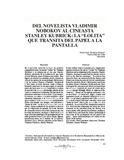Del novelista Vladimir Nobokov al cineasta Stanley Kubrick: La “Lolita” que transita del papel a la pantalla
Fecha
2010-12-31Palabras Clave
Novela, Narrativa, Texto fílmico, Vladimir Nabokov, Stanley KubrickNovel, Narrative, Filmic text, Vladimir Nabokov, Stanley Kubrick
Metadatos
Mostrar el registro completo del ítemResumen
En el presente artículo se hace un análisis comparativo entre la novela “Lolita” de Vladimir Nabokov y su adaptación al cine por Stanley Kubrick, partiendo de la evidencia de que tanto
el texto literario como el fílmico son relatos. Para lograr este objetivo se analizan, desde el punto de vista de los aportes de la narratología (Benveniste) y de las teorías fílmicas (Chatman, Gaudreault
y Jost) tanto el texto literario como el fílmico tomando como base el concepto según el cual toda narración tiene una historia (contenido) o cadena
de sucesos y un discurso (los medios a través de los cuales se comunica el contenido). En función de los parámetros anteriores se describen: 1) personajes,
escenarios, acciones y acontecimientos como elementos inherentes a la historia (el qué de lo que se relata) y 2) la forma narrativa propiamente dicha relacionada con tiempo, voz narrativa y
“punto de vista”, es decir, el discurso (el cómo se relata). Como resultado de este análisis se observa que la adaptación ha tomado del texto literario
los elementos básicos del relato (enunciación con focalización interna, analepsis o fl ash-back) y el tema (obsesión patológica del protagonista por las niñas preadolescentes), a lo cual se suman algunas
transformaciones en el ámbito de la historia.
Colecciones
Información Adicional
| Otros Títulos | From the Novelist Vladimir Nobokov to the film maker Stanley Kubrick: The “Lolita” which passes from the paper to the screen |
| Correo Electrónico | mimber@hotmail.com |
| Editor | SABER-ULA |
| Resumen en otro Idioma | In this written work it is produced a comparative analysis between the novel “Lolita” by Vladimir Nabokov and its adaptation to the cinema by Stanley Kubrick, bearing in mind that the literary text as well as the fi lm are narrations. To achieve this objective there are analyzed both the literary and fi lmic texts, from the point of view of contributions from the narrative theory (Benveniste) and from the fi lmic theory (Chatman, Gaudreault and Jost), relying on the concept as per which each narration has a history (context) or series of events and a speech (means through which is expressed the context). Based on foregoing parameters are so described: 1) characters, stages, actions and important events, as elements inherent to history (the what of what is narrated), and 2) the narrative form itself related with time, narrative voice and “point of view”, that is, the speech (the how it is narrated). As a result of this comparative analysis it is observed that adaptation has taken the basic elements of the narration from the literary text (enunciation with internal focalization, analepsis or fl ash-back) and from the theme (pathological obsession of the protagonist for pre-adolescent girls). Some transformations are added in the limits of the history. |
| Colación | 43-54 |
| País | Venezuela |
| Publicación Electrónica | Revista Cifra Nueva |
| Sección | Revista Cifra Nueva: Artículos |






